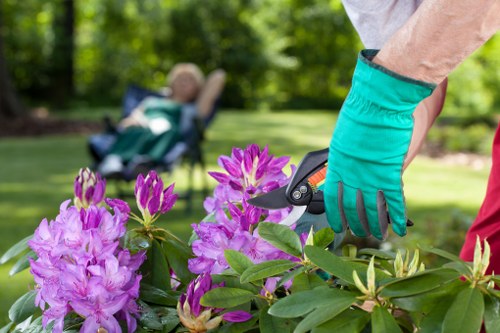Hedge Trimming in Temples: Preserving Sacred Greenery
Introduction to Hedge Trimming in Temples

Hedge trimming plays a crucial role in maintaining the serene and sacred atmosphere of temples. The meticulous care given to the greenery reflects the reverence and dedication of the caretakers. Proper hedge maintenance ensures that the temple grounds remain aesthetically pleasing and spiritually uplifting for devotees and visitors alike.
In many cultures, temples are not just places of worship but also gardens of tranquility. The hedges, often intricately shaped and meticulously trimmed, contribute to the overall harmony and balance of the sacred space. This article delves into the art and importance of hedge trimming in temples, exploring techniques, benefits, and best practices.
Maintaining temple hedges requires a blend of skill, knowledge, and respect for the natural environment. It involves understanding the specific needs of different plant species, seasonal growth patterns, and the symbolic significance of various hedge designs. Whether it’s the precise topiary forms or the naturalistic styles, each hedge serves a purpose in enhancing the spiritual ambiance of the temple.
Importance of Hedge Trimming in Sacred Spaces

Hedge trimming in temples is more than just landscaping; it is an expression of devotion and care for the divine space. Well-maintained hedges contribute to the sanctity and purity of the temple environment. They create a peaceful setting that fosters contemplation, meditation, and prayer.
The aesthetic appeal of trimmed hedges also plays a significant role in attracting devotees. The visual harmony created by orderly and well-shaped hedges enhances the overall experience, making the temple a more inviting and comforting place for spiritual activities.
Moreover, hedge trimming helps in maintaining the ecological balance within the temple grounds. Proper pruning ensures healthy plant growth, prevents overgrowth, and reduces the risk of pests and diseases. This not only preserves the beauty of the temple gardens but also supports the sustainability of the local ecosystem.
Techniques for Effective Hedge Trimming

Effective hedge trimming requires a combination of traditional practices and modern techniques. Understanding the specific characteristics of the hedge plants is essential for achieving the desired shape and health.
Pruning Tools and Their Uses
Using the right tools is fundamental to successful hedge trimming. Common tools include:
- Pruning Shears: Ideal for trimming small branches and shaping.
- Hedge Trimmers: Useful for cutting larger areas quickly and efficiently.
- Loppers: Suitable for thicker branches that shears cannot handle.
- Pruning Saw: Necessary for cutting very thick branches.
Maintaining Cutting Tools
Regular maintenance of pruning tools ensures their effectiveness and longevity. Clean tools prevent the spread of diseases, while sharp blades make precise cuts, promoting healthy plant growth.
Seasonal Hedge Maintenance

Different seasons require varied approaches to hedge trimming. Understanding seasonal growth patterns helps in planning maintenance activities effectively.
Spring Trimming
Spring is an ideal time for rejuvenating hedges after winter. Light pruning encourages new growth and helps shape the hedges before the growing season.
Summer Maintenance
During summer, focus on controlling excessive growth and maintaining the desired shape. Regular trimming prevents hedges from becoming unruly and ensures they remain healthy.
Autumn Care
Autumn trimming prepares hedges for the dormant winter period. Removing dead or damaged branches reduces the risk of diseases and sets the stage for robust growth in the spring.
Benefits of Regular Hedge Trimming in Temples

Regular hedge trimming in temples offers numerous benefits:
- Aesthetic Appeal: Well-maintained hedges enhance the beauty of the temple grounds, creating a welcoming environment for devotees.
- Health of Plants: Pruning promotes healthy growth, prevents diseases, and extends the lifespan of hedge plants.
- Environmental Harmony: Maintained greenery supports local biodiversity and contributes to a balanced ecosystem.
- Spiritual Upliftment: The tranquil and orderly appearance of trimmed hedges fosters a serene atmosphere conducive to worship and meditation.
Enhancing Devotee Experience
The visual harmony achieved through hedge trimming positively impacts the overall experience of temple visitors. Aesthetic landscapes create a sense of peace and reverence, enhancing the spiritual journey of individuals.
Sustainability and Eco-friendliness
Proper hedge maintenance promotes sustainability by ensuring that plants remain healthy and require fewer resources. This eco-friendly approach aligns with the values of many spiritual traditions that emphasize harmony with nature.
Long-term Cost Savings
Regular maintenance reduces the need for extensive repairs or replacements, resulting in long-term cost savings for temple administrations.
Choosing the Right Plants for Temple Hedges
Selecting appropriate plants is vital for effective hedge trimming and maintenance. Factors to consider include growth rate, resilience, aesthetic appeal, and symbolic significance.
Common Hedge Plants in Temples
- Bamboo: Known for its rapid growth and flexibility, bamboo is often used for creating elegant and flowing hedge shapes.
- Boxwood: Valued for its dense foliage and ability to hold intricate shapes, boxwood is a popular choice for formal hedges.
- Privet: A versatile plant that responds well to trimming, making it ideal for various hedge styles.
- Holly: With its glossy leaves and bright berries, holly adds visual interest and symbolizes protection.
Symbolic Plants
In many temples, specific plants hold symbolic meanings. Incorporating these plants into hedge designs adds a layer of spiritual significance to the temple gardens.
Cultural Significance
Understanding the cultural and religious importance of certain plants ensures that hedge designs align with the temple’s ethos and traditions.
Best Practices for Hedge Trimming in Temples
Implementing best practices ensures that hedge trimming is done efficiently and respectfully.
Timing and Frequency
Regular trimming schedules based on plant growth cycles help maintain the desired shape and health of hedges. Avoid trimming during peak blooming periods to preserve the natural beauty of flowering hedges.
Respecting Sacred Spaces
Trimming should be performed with mindfulness and respect for the sacred nature of temple grounds. Workers should be trained to handle plants gently and avoid causing unnecessary damage.
Integrating Sustainability
Adopt sustainable practices such as using eco-friendly trimming techniques and recycling plant waste. This approach supports environmental stewardship and aligns with many religious teachings on caring for nature.
Training and Expertise
Ensuring that those responsible for hedge trimming possess the necessary skills and knowledge leads to better outcomes and maintains the integrity of the temple’s landscape.
Innovative Hedge Trimming Techniques
Modern advancements have introduced innovative techniques that enhance the efficiency and artistry of hedge trimming in temples.
Topiary Art
Topiary involves shaping hedges into intricate designs and forms, adding a creative flair to temple gardens. This technique requires precision and artistic vision.
Automated Trimming Systems
Automated hedge trimmers can significantly reduce manual labor and increase precision, especially for large temples with extensive grounds.
Eco-friendly Practices
Incorporating eco-friendly practices such as using electric trimmers instead of gas-powered ones minimizes the environmental impact of hedge maintenance.
Technological Integration
Integrating technology with traditional hedge trimming methods can optimize maintenance schedules, improve efficiency, and enhance the overall quality of the temple’s greenery.
Challenges in Hedge Trimming for Temples
Maintaining hedges in temple environments presents unique challenges that require thoughtful solutions.
Environmental Factors
Weather conditions, pests, and diseases can impact hedge health. Implementing preventive measures and responsive strategies is essential for sustained maintenance.
Resource Management
Balancing the use of water, fertilizers, and other resources ensures that hedge trimming practices are sustainable and do not deplete the temple’s resources.
Cultural Sensitivities
Understanding and respecting the cultural sensitivities associated with temple grounds is crucial. Maintenance practices must align with the spiritual values and traditions of the temple community.
Adapting to Changes
As temple landscapes evolve, hedge trimming practices must adapt to new plant varieties, design changes, and shifting environmental conditions.
Conclusion: The Essence of Hedge Trimming in Temples
Hedge trimming in temples is a harmonious blend of art, skill, and reverence for nature. It plays a vital role in creating and maintaining sacred spaces that inspire and uplift the spirit.
Preserving Sacred Beauty
Through diligent maintenance, temple hedges remain a testament to the care and devotion invested in the sacred grounds. They enhance the spiritual experience, providing a tranquil environment for worship and reflection.
Encouraging Sustainable Practices
Adopting sustainable hedge trimming practices ensures that temple gardens continue to flourish for generations to come, maintaining their beauty and ecological balance.
Invitation to Action
Contact us today to learn more about professional hedge trimming services tailored for temple landscapes. Let us help you preserve the serenity and beauty of your sacred space.